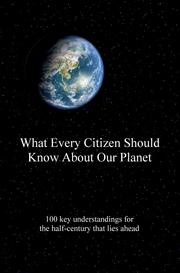Check nearby libraries
Buy this book

Beginning with a world population of two billion in 1930, we will reach seven billion sometime late in 2011 (amounting to FIVE billion additional people in a single human lifetime), followed by still more billions (numbers eight and nine) on-track to arrive by 2041 and by the arrival of a tenth billion by century's end (or, if worldwide fertility averages just 1/2 child per woman higher, more than Fifteen billion by 2100).
Check nearby libraries
Buy this book

Subjects
population, ecology, sustainability, overpopulation, environment, carrying capacity, demography, limiting factors, biodiversity, science, overshoot, climb-and-collapse, J-curves, exponential, non-linear, world affairs, current events, governance, instability, international affairsPlaces
China, the Middle East, Madison Square Garden, Rome, Mediterranean basin, Alaska, Madagascar, Canada, New England, California, Arizona, Pacific Ocean, Venus, Mumbai, Tokyo, Cairo, Liberia, Los Angeles, NYC, Rio de Janiero, Mars, Australia, New Zealand, Greenland, Aral Sea, Sri Lanka, Brazil, Costa Rica, India, Pakistan, Bangladesh, Chad, Cameroon, Lagos, Davos, tropics, Easter Island, New OrleansShowing 1 featured edition. View all 1 editions?
| Edition | Availability |
|---|---|
|
1
What Every Citizen Should Know About Our Planet: Wecskaop III
Third Edition, 2010, M. Arman Publishing, Inc.
- Third Edition, 2010
0933078188 9780933078185
|
aaaa
Libraries near you:
WorldCat
|
Book Details
First Sentence
"We begin this book with what may be the single most important data set in the history of our species."
Table of Contents
Edition Notes
Excerpts and sample pdf downloads from this title are available at scribd.com, keyword "Wecskaop"
ID Numbers
Work Description
The book describes itself in the opening paragraphs of its preface. For example, "Beginning with a world population of two billion in 1930, we will reach seven billion late in 2011 (amounting to FIVE billion additional people in a single human lifetime), followed by still more billions (numbers eight and nine) on-track to arrive by 2041. As this book will show, the impending arrival of our 8th, 9th, and 10th billions by century's end (or even 15.8 billlion, if worldwide fertility averages just 1/2 child per woman higher than the U.N.'s most recent medium-fertility estimates), together with the levels of overpopulation and environmental impacts that we already exhibit, arguably comprise the most important data set in human history and a continuation of our current demographic tidal wave may constitute the greatest single risk that our species has ever undertaken."
Community Reviews (0)
Feedback?History
- Created August 20, 2008
- 39 revisions
Wikipedia citation
×CloseCopy and paste this code into your Wikipedia page. Need help?
| August 22, 2020 | Edited by ISBNbot2 | normalize ISBN |
| August 19, 2011 | Edited by Auggie | Updated cover and incorporated newest (May 2011) U.N. world population projections) |
| August 19, 2011 | Edited by Auggie | Added new cover |
| April 13, 2010 | Edited by Open Library Bot | Linked existing covers to the edition. |
| August 20, 2008 | Created by 4.235.251.107 | entered descriptive, subject, and genre info |










